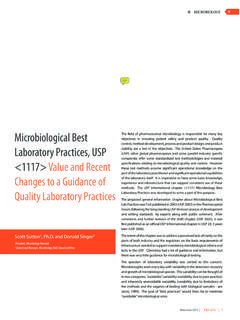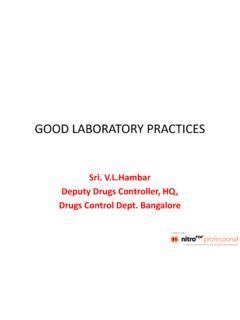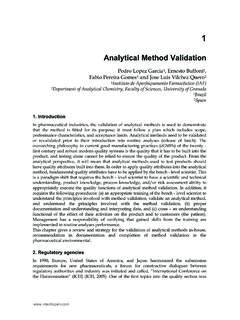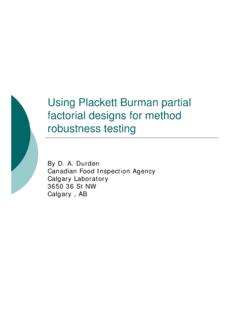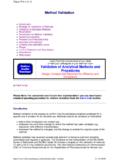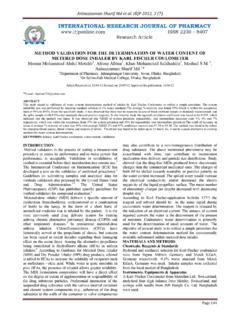Transcription of Review of USP Chapter <1223> Validation of Alternative ...
1 Review of USP Chapter <I 223> Validation of Alternative microbiological methods Presented at the 2007 global conference on pharmaceutical microbiology David A. Porter, Formerly with USP Introduction T his article is based on a presentation given by the author on USP Chapter <1223> Validation of Alternative microbiological methods during the 2007 PDA global conference on pharmaceutical microbiology , held in Bethesda, Md, October 30 - November 1, 2007. The author has had a few further thoughts on the subject that will be given in the conclu- sion of this article. Several regulatory documents have a bearing on our under- standing of USP Chapter <1223>. The first of these is the draft guidance document on Comparability Protocols [I]. Comparability Protocols are used in part to address modifications to methods used in previous filings to the FDA. This method has been identified by the FDA as the preferred method for introduc- ing alternate microbiological methods into an approved product submission.
2 GMPs for the 21st Century -A Risk-based Approach (Sept. 29, 2004) is also relevant to this discussion [2]. This document draws together many regulatory guidance documents relevant to GMP, and provides web-based links to access the information. Two guidance documents referred to in this 2004 report deserve special attention: "Guidance for Industry: Sterile Drug Products Produced by Aseptic Processing - Current Good Manufacturing Practice" and "Guidance for Industry PAT - A Framework for Innovative pharmaceutical Development, Manufacturing and Quality Assurance." The potential use of PAT (process analytical technology) exists for alternate microbiological methods , partic- ularly rapid ones as microbiological analyses account for the majority of the manufacturing timeline [3-61. PDA Technical Report 33 (PDA TR #33) "Evaluation, Validation and Implementation of New microbiological Testing methods " is considered to be, in a sense, the predecessor of chap- ter <1223>.]
3 It considered the Validation of microbiological meth- ods to be necessarily approached in a different manner from the Validation of chemical methods . Sections from TR 33 delineated were: Vendor and Method Requirements, Designing the Validation Plan. Installation Oualification (10). Operational .. A Qualification (OQ) and Performance Qualification (PQ). Finally, any discussion of Validation must address the statis- tics of the system. This is a particularly difficult subject with microbiology as the numbers obtained generally do not follow a "normal" distribution. Given the importance of the appropriate application of statistical methods well-suited to the data and ana- 76 American pharmaceutical Review / ~~ - - microbiology lytical needs, microbiologists should feel free to consult any of the many available references, including the three references that were provided [7-91.]
4 USP Chapter <1010> Analytical Data- Interpretation and Treatment [lo] is also a good reference. Development of Compendia1 Chapters There are currently two official compendia1 chapters cov- ering the Validation of Alternative microbiological methods . From a single pattern of dots .. These are the European Pharmacopeia's " Alternative methods for Control of microbiological Quality" [Ill and the USP's "<1223> Validation of Alternative microbiological methods " [12]. The publication history of Chapter <1223> is enlightening. The first version of the Chapter appeared in Pharmacopeial Forum (PF) in 2002 [13]. Many comments received concerned the Chapter being confusing and difficult to use. The USP expert committee (Analytical microbiology dur- ing the 2000-2005 USP cycle of revision) in charge of the chap- ter responded to those comments by preparing another version that was pub- I lished one year later [14].]
5 The nature of the comments was virtually unchanged. Therefore, the experts decided a major rewrite was in order, and the next version, published in 2005 [15], had the entire section pertaining to Validation of micro- biological identification removed. This was done to simplify the topic and focus the Chapter [16]. It was this version that became official in the 2nd Supplement. Please circle #40 Relative standard deviations (RSD) of 15 to 35 percent are common, whereas for analytical chemistry methods , typical RSDs range between one and three per- cent. The RSD is defined as the standard deviation divided by the mean. American pharmaceutical Review The currently official version of the Chapter addresses the vali- dation of two types of microbiological methods : Qualitative tests and quantitative tests. A qualitative test is concerned with only one thing: are any viable microorganisms present.
6 This implies that the result from such a test is binary, as in something is there or isn't. The second type of method covered is quantitative. In such a method, one is clearly interested in measuring a range of microor- ganisms (enumerating them). The list of Validation elements to address differs depending upon the type of test. Quantitative microbiological tests require that the following Validation parameters be addressed: 1. Accuracy: The closeness of the test results obtained by the alternate test method to the value obtained by the traditional method. 2. Precision: The degree of agreement among individual test results when the procedure is applied repeatedly to multiple samplings of suspensions of laboratory microorganisms across the range of the test. 3. Specificity: The ability to detect a panel of microorganisms suitable to demonstrate that the method is fit for its intended purpose.
7 4. Limit of Quantification: The lowest number of microorgan- isms that can be accurately counted. 5. Linearity: The ability to produce results that are proportional to the concentration of microorgan- isms present in the sample within a given range. 6. Range: The interval between the upper and lower levels of microorgan- isms that have been demonstrated to be determined with precision, accura- cy and linearity. 7. Limit of Detection, Ruggedness and Robustness, with definitions equivalent to those for qualitative tests. Qualitative microbiological methods require considerably fewer data parameters be addressed. These parameters are: 1. Specificity: The ability to detect a range of microorganisms. 2. Limit of Detection: Determination of the lowest amount detectable, that is to say, the minimum number that will generate a signal above the back- ground noise. 3. Ruggedness: The resistance to influences of operational and environ- mental variables (often considered random effects).
8 4. Robustness: The capacity to remain unaffected by small but deliberate (nonrandom) variations in method parameters. There arc a couple of general notes about the compendial methods . First, the microorganisms that should be included in the method Validation should represent species of importance to one's spe- cific requirements. If one finds a particular species during envi- ronmental monitoring that is not included in pharmacopeial lists, its exclusion from the pharmacopeia does not obviate the need for tracking this particular species. Second, Validation of an Alternative method to a compendial method is comparative in nature. Therefore, all data elements listed above should involve comparisons between the results of the Alternative and compen- dial methods . The requirement is that the Alternative method results be equivalent or better than the compendial method results. Differences Between the EP and the USP Chapters The two compendial chapters are similar in many respects.
9 The differences are substantial in other respects. For example, the USP Chapter does not address the Validation of microbial identification methods , whereas the EP Chapter does. The USP Chapter has dropped the parameters of accuracy and precision from the list to be addressed for qualitative methods . This is because the USP considers these parameters to be operationally no different from the limit of detection. There are other differ- Please circle #4 1 79 American pharmaceutical Review -- -- microbiology ences of a more statistical nature. methods make certain assumptions about underlying data distri- butions that should be verified. Also, some methods are better Conclusion suited to smaller sample sizes than others. Always remember that there are always several ways to skin the microbiological cat sta- My impression Erom talking to many people about this tistically. Chapter is that it does serve a useful function.
10 Recently, I have heard some interesting concerns about this Chapter . One concern is that perhaps this Chapter is slanted too much towards rapid References microbiological methods . This may be reflected in portions of 1. Comparability Protocols - Chemistry, Manufacturing, and the Chapter text pertaining to robustness and ruggedness. Here, it Controls Information " (DRAFT (2/03) is suggested that much of the responsibility for the Validation of these parameters rests with the vendor of the method. One could 2. http://w ww. reasonably infer the use of rapid methods here, since most of these are instrument-dependent. From a compendia1 perspective, 3. Singer, DC and AM Cundell. 2003. The Role of Rapid this underplays the importance of having potentially affected par- microbiological methods within the Process Analytical ties of a new method try the method using their own test articles, Technology Initiative.)


